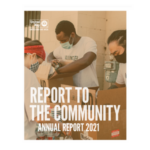Search
DISMANTLING POVERTY THROUGH COMMUNITY COLLEGES
August 23, 2021

By: Kevin Zwick
Sparky Harlan, the long-time CEO of Bill Wilson Center in Santa Clara, CA, is the most dedicated leader housing homeless youth that I’ve come to know in my 25 years working in the nonprofit sector. So, in 2017, when she and I had one of our periodic coffee meetings, I distinctly remember when she told me that they were about to release a report that was going to shock us all and we had better get ready to do something about it. That report, which would be released as “Hidden In Plain Sight: Documenting Homeless Youth Population” was a first-of-its-kind study that aimed to count the hidden homeless youth who were a part of our high school and community college systems, and it was heart-breaking: there were over 13,000 high school students and over 17,000 young adult students aged 18-25 in Santa Clara County who had experienced homelessness in the past six months. Over 44% of community college students had experienced homelessness or knew another student who had. They were couch-surfing, or sleeping on friends’ floors, or in their cars or on the streets. I could only imagine how hard it would be for those students who were going to school — to give themselves the chance they need to get a job that would allow them to afford to stay in our region, or to help them get to a four-year college — while also struggling to meet their basic needs.
As students across the Bay Area start classes this month, I’m paying close attention to students at our local Community Colleges. Among California Community College students, 60% of respondents were housing insecure in the previous year, and 19% of respondents were homeless in the previous year, according to the 2019 #RealCollege survey, the largest survey of community college students conducted nationally. In addition, 50% of respondents indicated they were food insecure in the prior 30 days. The COVID-19 pandemic has further stressed these young people financially. They are among the most vulnerable college students in the region, and we’re working directly in these communities to ensure the setbacks they faced during this pandemic don’t hold them back for a lifetime.
Community Colleges play a critical role in dismantling the root causes of poverty. Students earning a degree or certificate from a California community college nearly double their earnings within three years, and attending or graduating from a California Community College nearly doubles one’s chances of finding a job compared to those who failed to complete high school. Community colleges are often the environments where individuals begin their path out of poverty and embark on a path to prosperity. Due to their relatively low cost (which we hope will become no cost in the future), there is a low financial barrier to enroll. First Lady, Dr. Jill Biden, has taught at a community college for years and has been an advocate for free access to community college and training programs for everyone. Additionally, community colleges are important sites within the community, as they host free vaccination clinics, farmers’ markets, fine arts performances, and are gathering places for special events in the community.
Yet we know that community college enrollment has declined, and that students face real challenges that have been exacerbated by the COVID-19 pandemic. That’s why SparkPoint centers, powered by United Way Bay Area, located onsite at community colleges across the region and operated in partnership with nonprofit community groups, are critical for supporting community college students. The students we support at SparkPoint centers are more likely than their peers to stay enrolled in school. To expand access to SparkPoint’s vital services, we are building out a comprehensive toolkit that would allow any post-secondary institution to plan and build out a SparkPoint center on campus, thanks to a grant from the College Futures Foundation. Thanks to the work of statewide youth advocates and Bay Area state Assembly member Marc Berman, the state budget signed by Governor Newsom last month includes $30 million for community colleges to build out basic needs centers and hire basic needs coordinators at every community college. Given this big task, we stand ready to support our Community College districts, and welcome the opportunity to share our SparkPoint toolkit and discuss how it may become a useful tool in this process for many institutions.
A student at Chabot College wrote, “Currently, I’m facing economic hardship because of the pandemic. I’m a full-time student at Chabot College and it is difficult for me to have school supplies because I do not have the funds. This situation makes it difficult for me to concentrate on my studies. I need financial assistance for numerous things such as medical bills, school supplies, food, insurance and rent. I am staying optimistic and hopefully one day my situation will change for the better. Currently I’m owing my boss three months of rent.” Through Chabot College’s SparkPoint Center, the client received $1,500 in rental assistance and a Target e-card for groceries. They are continuing to use SparkPoint services for financial coaching and support, making great strides toward financial stability.
The setbacks our high school and college students are facing this pandemic could last a lifetime. But by supporting financial coaching and services for community college students through United Way Bay Area’s SparkPoint centers, we can ensure more students have the capabilities and assets to remain housed during hard financial times.
For more:
Learn about United Way Bay Area SparkPoint centers
Learn about the impact SparkPoint centers have had on students (PDF)


